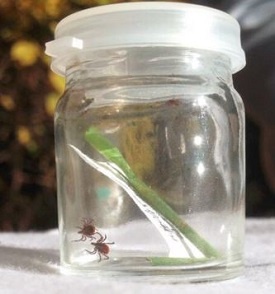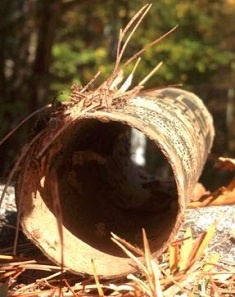Prevent Ticks and The Spread of Disease
As the leaves change and winter approaches, the fear of ticks and tick-borne disease seems to fade from people’s thoughts. Fall is a beautiful time to enjoy outdoor activities, such as camping, hiking, and fishing, but be aware that with the cooler weather comes the next wave of ticks.

Fall is the time when the adult stage of blacklegged ticks begins to emerge in full force. Blacklegged ticks, also known as deer ticks, are the primary culprits involved in the transmission of Lyme disease, as well as a barrage of other pathogens. Deer ticks require two years to complete their life cycle from egg to larvae to nymph to adult. Adults are typically active from October to May and can be found throughout the winter if the temperature exceeds 40 degrees Fahrenheit. Females lay an egg mass in late spring then larvae emerge in late summer. After a blood meal, the larvae will molt over winter and re-emerge the following spring as a nymph. Nymphs are most active from May through August. The poppy seed-sized nymphs are known to be the most responsible in human disease transmission due to their extremely small size, often going unnoticed when attached. Additionally, the nymphal ticks have experienced increased disease exposure from infected hosts during the prior summer.
Any Integrated Tick Management Program should strive to reduce the risk of tick-borne disease transmission. Reducing tick populations and the risk of disease transmission is best accomplished through a combination of methods including surveillance, identification, disease testing, landscape management and targeted application to control adult ticks.
 The cornerstone of any successful tick control operation should be based on surveillance and habitat identification to allow for highly targeted applications when necessary. Deer ticks require high humidity, so they tend to be associated with habitats that are heavily shaded, damp, and covered with leaf litter. Tick habitats also include areas where hosts (deer and mice) are frequently observed such as brush piles, stone wall bases, wood piles, wooded areas, edges of fields, and areas with low dense woody vegetation. Once these habitats are identified and mapped, using GPS technology, an action plan can be developed for tick control applications.
The cornerstone of any successful tick control operation should be based on surveillance and habitat identification to allow for highly targeted applications when necessary. Deer ticks require high humidity, so they tend to be associated with habitats that are heavily shaded, damp, and covered with leaf litter. Tick habitats also include areas where hosts (deer and mice) are frequently observed such as brush piles, stone wall bases, wood piles, wooded areas, edges of fields, and areas with low dense woody vegetation. Once these habitats are identified and mapped, using GPS technology, an action plan can be developed for tick control applications.
Landscape management is a non-chemical strategy to lessen tick habitat. Reducing potential exposure to ticks by making environments unattractive to their hosts and unsuitable for tick survival should be an integral part of any tick management program. Deer ticks are not typically found in the middle of a lawn; they live where the lawn borders wooded areas or shady areas with high humidity. “Tick Safe” zones can be created by raking leaves, trimming shrubs and other low vegetation to reduce ground humidity. Additionally, creating borders of wood chips along the edge of wooded areas can serve as a reminder between “tick-safe” and “tick-danger” zones.
Ticks become infected with disease-causing agents when they feed on reservoir hosts. Many studies suggest that white-footed mice are the main reservoir host for Lyme disease, Babesiosis, and Anaplasmosis. Consequently, in most settings mice are the primary culprits for producing infected ticks.

Tick tubes are host-targeted devices filled with cotton nesting materials laced with Permethrin. When the tubes are placed in mouse breeding habitats (stone walls, brush piles, wood piles) mice will use the materials and place it in their nests causing any live ticks to detach and die. The chemical soaked cotton material is not harmful to the mice and it will reduce the number of infected ticks on the property. Tick tubes are biodegradable and the risk for environmental contamination is extremely low.
The most common and effective methods to manage tick populations are perimeter sprays and chemical ground treatments. The environmental impact of tick treatments can be reduced by limiting the amount of pesticide being applied and targeting the specific areas where people will most likely come in contact with ticks. The products used for ground applications are used at very low concentrations and have a low toxicity to humans. When ticks are detected in an area, they can be effectively controlled through the application of ground sprays or granular acarides. Dependent upon the conditions present, granular, liquid or time-release formulations are applied directly to tick habitat. The optimum timing for application is late May to early June for nymphal ticks followed by a fall application to treat adult ticks. Like any successful pest management program, successfully controlling ticks relies on awareness, education and knowledge of the pest life cycle. Being familiar with the most important components of tick management allows for everyone to have a safe experience enjoying the outdoors.
Should you have any questions regarding tick management, Vector Disease Control International (VDCI) is always available at whatever level of assistance you desire.
Contact Us to Learn More About Effective Mosquito Management Strategies:
 Since 1992, Vector Disease Control International (VDCI) has taken pride in providing municipalities, mosquito abatement districts, industrial sites, planned communities, homeowners associations, and golf courses with the tools they need to run effective mosquito control programs. We are determined to protect the public health of the communities in which we operate. Our mosquito control professionals have over 100 years of combined experience in the field of public health, specifically vector disease control. We strive to provide the most effective and scientifically sound mosquito surveillance and control programs possible based on an Integrated Mosquito Management approach recommended by the American Mosquito Control Association (AMCA) and Centers for Disease Control and Prevention (CDC). VDCI is the only company in the country that can manage all aspects of an integrated mosquito management program, from surveillance to disease testing to aerial application in emergency situations.
Since 1992, Vector Disease Control International (VDCI) has taken pride in providing municipalities, mosquito abatement districts, industrial sites, planned communities, homeowners associations, and golf courses with the tools they need to run effective mosquito control programs. We are determined to protect the public health of the communities in which we operate. Our mosquito control professionals have over 100 years of combined experience in the field of public health, specifically vector disease control. We strive to provide the most effective and scientifically sound mosquito surveillance and control programs possible based on an Integrated Mosquito Management approach recommended by the American Mosquito Control Association (AMCA) and Centers for Disease Control and Prevention (CDC). VDCI is the only company in the country that can manage all aspects of an integrated mosquito management program, from surveillance to disease testing to aerial application in emergency situations.

